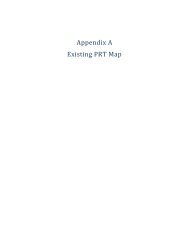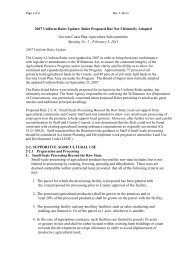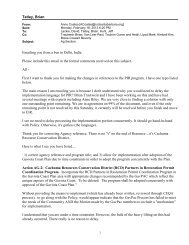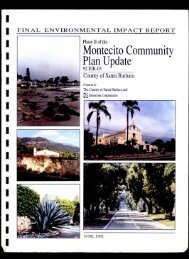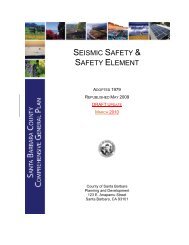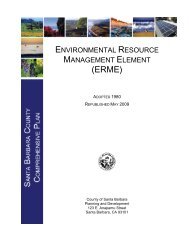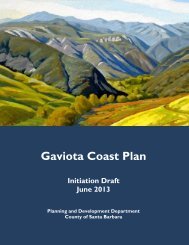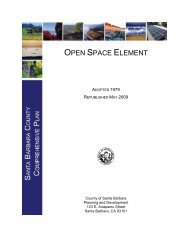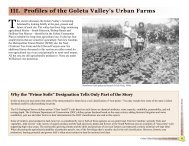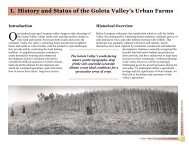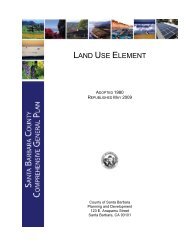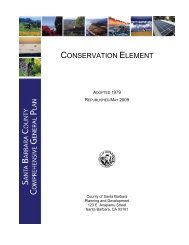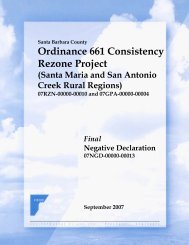Gaviotia layout 4 - PM 7.0 - Ocean and Coastal Policy Center ...
Gaviotia layout 4 - PM 7.0 - Ocean and Coastal Policy Center ...
Gaviotia layout 4 - PM 7.0 - Ocean and Coastal Policy Center ...
You also want an ePaper? Increase the reach of your titles
YUMPU automatically turns print PDFs into web optimized ePapers that Google loves.
Stewardship<br />
p <br />
What a ‘watershed information network’ should do:<br />
▼<br />
▼<br />
▼<br />
▼<br />
▼<br />
Provide a neutral forum for discussion <strong>and</strong> partnership in collaborative watershedbased<br />
planning <strong>and</strong> general ecosystem-based protection;<br />
Aid in gathering <strong>and</strong> synthesis of important economic <strong>and</strong> ecological information;<br />
Strengthen the baseline information on the ecology <strong>and</strong> economics of the coast;<br />
Improve the ecological <strong>and</strong> cultural underst<strong>and</strong>ing of the watersheds of the Gaviota<br />
coast, especially those that include habitat for wild southern steelhead recovery<br />
projects; <strong>and</strong><br />
Establish a Scientific Advisory Panel that is made up of both social <strong>and</strong> physical<br />
scientists with regional expertise (the Scientific Advisory Panel will assist the Gaviota<br />
watershed plan development <strong>and</strong> implementation effort).<br />
Real-life examples of local watershed planning:<br />
Two local examples exist. The first is the San Antonio Creek Coordinated Resource<br />
Management Plan — prepared by the Cachuma Resource Conservation District<br />
(RCD) in December 2003. The second is the Southern San Luis Obispo <strong>and</strong> Santa<br />
Barbara Counties Agricultural Watershed Coalition — a joint initiative by the Central<br />
Coast Regional Water Quality Control Board <strong>and</strong> several local agricultural<br />
organizations, including the County Farm Bureau. The purpose of the program is to<br />
assist owners <strong>and</strong> operators of cultivated agricultural l<strong>and</strong> to comply with federal<br />
clean water requirements for their agricultural runoff water, through training <strong>and</strong><br />
assistance to develop farm water quality plans <strong>and</strong> implement best management<br />
practices. Contact info for the program may be obtained at: http://<br />
www.waterboards.ca.gov/centralcoast/AGWaivers/Index.htm.<br />
Conserving <strong>and</strong> protecting natural resources<br />
5. Control, <strong>and</strong> where possible, eliminate invasive plants <strong>and</strong> replace with natives.<br />
a. Efforts should be funded to monitor <strong>and</strong> control the priority invasive plant species<br />
that threaten the diversity <strong>and</strong> sustainability of native floral <strong>and</strong> faunal<br />
communities.<br />
6. Restore <strong>and</strong> renovate degraded habitats in a manner consistent with continued<br />
agricultural use of the l<strong>and</strong>. In particular, improve water quality <strong>and</strong> watershed health<br />
where it has been degraded by human activity.<br />
a. Local, state <strong>and</strong> federal agencies should work together to streamline the<br />
permitting process <strong>and</strong> provide permit exemptions to make it easier for<br />
l<strong>and</strong>owners to undertake restoration activities.



